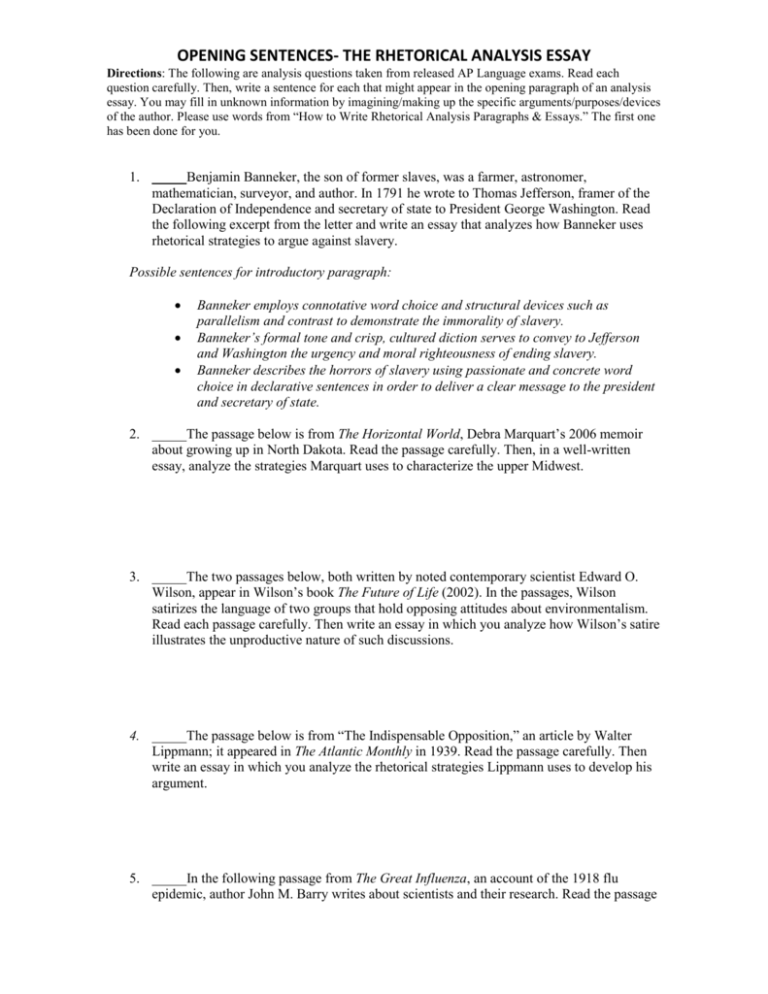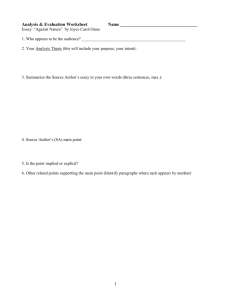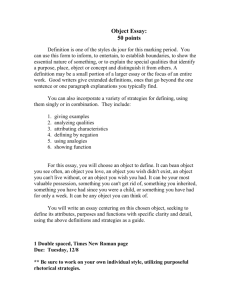AP Language Rhetorical Analysis Essay Prompts
advertisement

OPENING SENTENCES- THE RHETORICAL ANALYSIS ESSAY Directions: The following are analysis questions taken from released AP Language exams. Read each question carefully. Then, write a sentence for each that might appear in the opening paragraph of an analysis essay. You may fill in unknown information by imagining/making up the specific arguments/purposes/devices of the author. Please use words from “How to Write Rhetorical Analysis Paragraphs & Essays.” The first one has been done for you. 1. _____Benjamin Banneker, the son of former slaves, was a farmer, astronomer, mathematician, surveyor, and author. In 1791 he wrote to Thomas Jefferson, framer of the Declaration of Independence and secretary of state to President George Washington. Read the following excerpt from the letter and write an essay that analyzes how Banneker uses rhetorical strategies to argue against slavery. Possible sentences for introductory paragraph: Banneker employs connotative word choice and structural devices such as parallelism and contrast to demonstrate the immorality of slavery. Banneker’s formal tone and crisp, cultured diction serves to convey to Jefferson and Washington the urgency and moral righteousness of ending slavery. Banneker describes the horrors of slavery using passionate and concrete word choice in declarative sentences in order to deliver a clear message to the president and secretary of state. 2. _____The passage below is from The Horizontal World, Debra Marquart’s 2006 memoir about growing up in North Dakota. Read the passage carefully. Then, in a well-written essay, analyze the strategies Marquart uses to characterize the upper Midwest. 3. _____The two passages below, both written by noted contemporary scientist Edward O. Wilson, appear in Wilson’s book The Future of Life (2002). In the passages, Wilson satirizes the language of two groups that hold opposing attitudes about environmentalism. Read each passage carefully. Then write an essay in which you analyze how Wilson’s satire illustrates the unproductive nature of such discussions. 4. _____The passage below is from “The Indispensable Opposition,” an article by Walter Lippmann; it appeared in The Atlantic Monthly in 1939. Read the passage carefully. Then write an essay in which you analyze the rhetorical strategies Lippmann uses to develop his argument. 5. _____In the following passage from The Great Influenza, an account of the 1918 flu epidemic, author John M. Barry writes about scientists and their research. Read the passage OPENING SENTENCES- THE RHETORICAL ANALYSIS ESSAY Directions: The following are analysis questions taken from released AP Language exams. Read each question carefully. Then, write a sentence for each that might appear in the opening paragraph of an analysis essay. You may fill in unknown information by imagining/making up the specific arguments/purposes/devices of the author. Please use words from “How to Write Rhetorical Analysis Paragraphs & Essays.” The first one has been done for you. carefully. Then, in a well-written essay, analyze how Barry uses rhetorical strategies to characterize scientific research. 6. _____Read the following passage from “America Needs Its Nerds” by Leonid Fridman. Then write an essay in which you analyze how Fridman develops his argument. 7. The following article is a mock press release from The Onion, a publication devoted to humor and satire. Read the article carefully. Then write an essay in which you analyze the strategies used in the article to satirize how products are marketed to consumers. 8. _____The passage below is an excerpt from a lecture delivered in Boston in 1832, by Maria W. Stewart, an African American educator and writer. Read the passage carefully. Then write an essay in which you analyze the rhetorical strategies Stewart uses to convey her convictions. 9. _____In 1962, the noted biologist Rachel Carson published Silent Spring, a book that helped to transform American attitudes toward the environment. Carefully read the following passage from Silent Spring. Then write an essay in which you define the central argument of the passage and analyze the rhetorical strategies that Carson uses to construct her argument. 10. _____In 1830 John Downe, a weaver, traveled to the United States from England and took a job so that he could earn enough money to enable his wife and children to join him. Read the following letter from Downe to his wife. Then write an essay in which you analyze the rhetorical strategies that Downe uses to convince his wife to emigrate to the United States.





